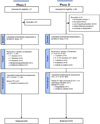Harm Reduction Behavioral Activation Teletherapy for People Who Inject Drugs: Development, Feasibility, and Acceptability
- PMID: 40786619
- PMCID: PMC12332520
- DOI: 10.1016/j.cbpra.2024.03.002
Harm Reduction Behavioral Activation Teletherapy for People Who Inject Drugs: Development, Feasibility, and Acceptability
Abstract
People who inject drugs (PWID) experience severe substance-related harms and yet have low rates of engagement in substance use disorder treatment. Low-barrier and telepsychology interventions represent promising strategies for engaging PWID in treatment, but few studies have tested the feasibility of these approaches among non-treatment-seeking PWID. A behavioral activation (BA) treatment for substance use was adapted through a harm reduction lens to assist PWID in working toward healthy, meaningful lives and achieving their goals. This study aims to: (a) describe the development and harm reduction-focused adaptation of the BA intervention, and (b) examine the feasibility and acceptability of administering a telepsychology BA treatment for substance use among non-treatment-seeking PWID. We recruited N = 23 PWID (65.2% White; 52.2% women; mean age 35.4±7.8 years) from syringe services programs into an open trial and n = 19 received up to eight sessions of BA over 4 weeks. Qualitative treatment feedback interviews occurred at posttreatment. Among those who attended ≥1 session of treatment, 84% attended a second assessment, and 58% attended ≥7 intervention sessions. Feasibility challenges were primarily related to participant vulnerabilities (e.g., hospitalization, incarceration, loss of access to technology). Participants indicated high acceptance of the intervention and its telepsychology format. In conclusion, while PWID face significant barriers to engaging in treatment, some also demonstrate a desire, willingness, and capacity for psychological intervention. Remote interventions may help increase feasibility of treatment participation. Future studies should examine longer harm reduction-focused treatments for PWID that balance barriers to initial engagement with the need to reinforce treatment gains and improve long-term outcomes.
Keywords: Behavioral Activation; Harm Reduction; behavioral interventions; injection drug use; people who inject drugs; psychosocial treatment; treatment development.
Figures
References
-
- American Psychological Association. (2019). Guidelines for psychological practice for people with low-income and economic marginalization. www.apa.org/about/policy/guidelines-lowincome.pdf - PubMed
-
- Attkisson CC, & Greenfield TK (2004). The UCSF Client Satisfaction Scales: I. The Client Satisfaction Questionnaire-8. In Maruish ME (Ed.), Use of psychological testing for treatment planning and outcomes assessment. Lawrence Erlbaum.
-
- Bellg AJ, Borrelli B, Resnick B, Hecht J, Minicucci DS, Ory M, Ogedegbe G, Orwig D, Ernst D, & Czajkowski S. (2004). Enhancing treatment fidelity in health behavior change studies: Best practices and recommendations from the NIH Behavior Change Consortium. Health Psychology, 23(5), 443–451. 10.1037/0278-6133.23.5.443 - DOI - PubMed
-
- Boyd J, Fast D, Hobbins M, McNeil R, & Small W. (2017). Social-structural factors influencing periods of injection cessation among marginalized youth who inject drugs in Vancouver, Canada: An ethno-epidemiological study [Article]. Harm Reduction Journal, 14, 1–11. 10.1186/s12954-017-0159-9 - DOI - PMC - PubMed
Grants and funding
LinkOut - more resources
Full Text Sources

